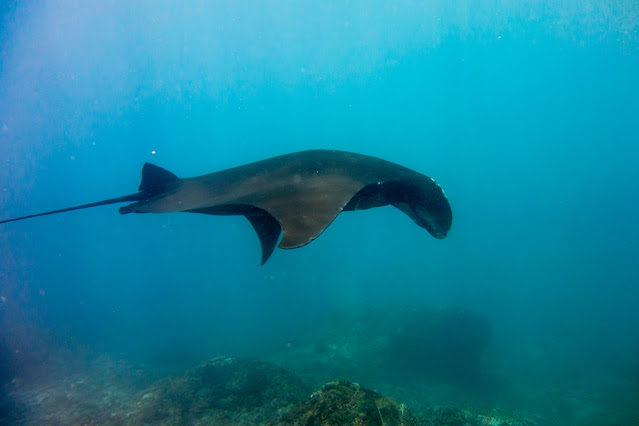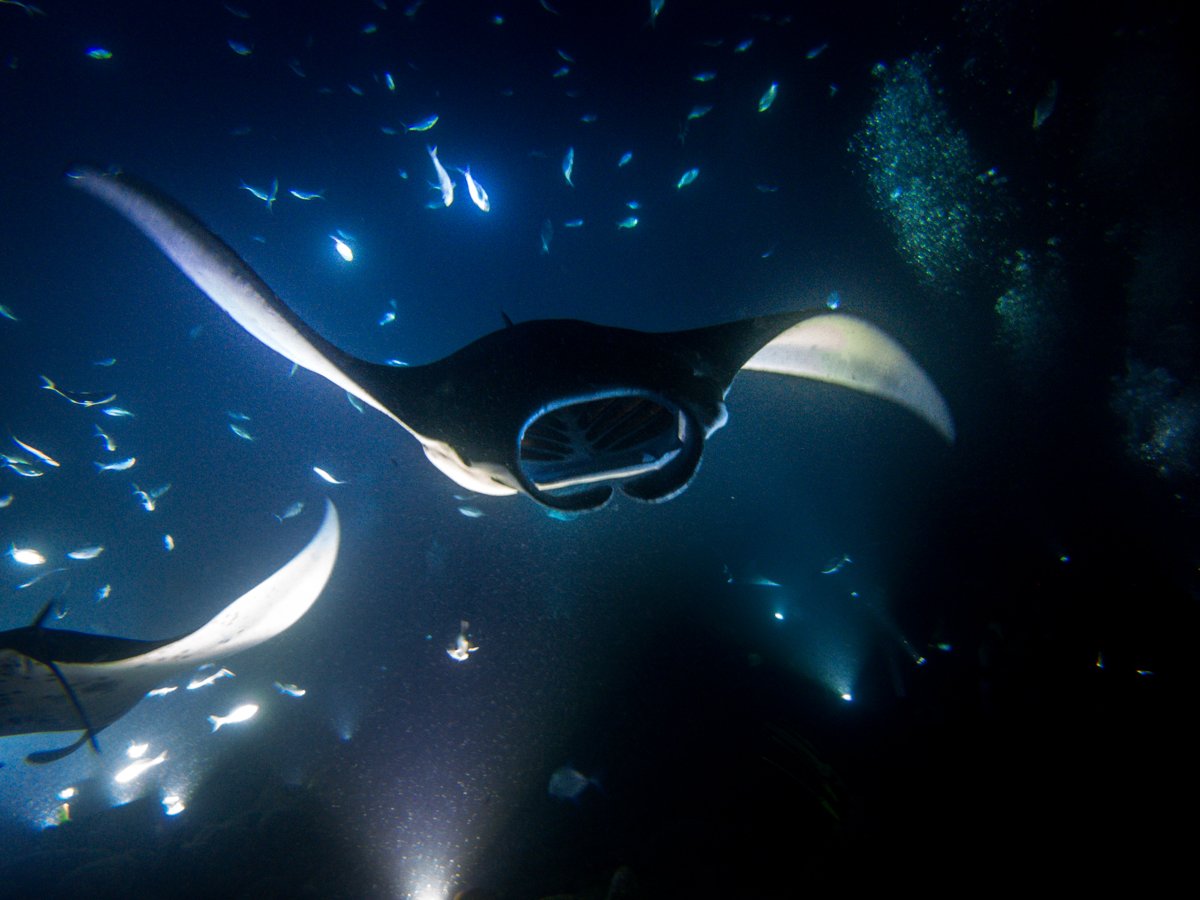Have you ever dreamed of becoming an astronaut and exploring distant planets? As a child, I personally did want to become one, but today as an adult I can only hope that (affordable) interstellar travel will be possible in my lifetime. That much for dreams, but the good news is one experience on our planet Earth will grant you arguably the closest sense of being in space: Night snorkeling/diving with Manta Rays Hawaii! A galactic experience where you watch the oceanic UFOs weighing more than a ton dart around millimeters away from you with the tiny fish shining like distant stars. Truly an epic display, sheer poetry of motion!

Before you embark on this exciting extraterrestrial trip, I’d like to invite you to get to know the Manta rays a little better to make the best out of your encounter with one of the most exotic marine creatures in the world. You won’t regret spending a little time reading some facts about Mantas, trust me.
My first encounter with manta rays was on a night dive in Hawaii, which was off the charts. A few years later in Bali, I thought a daytime encounter would not surpass my previous experience, but I couldn’t be more wrong. After partaking in a marine megafauna week of diving, and learning more about Manta rays, the encounter turned out to be a “Blue Planet” worthy sort that I was fascinated once again.
Please bear with me to find out where and how to be treated to a front-row seat to the hypnotizing ballet of mantas with their elegantly gigantic flat shapes. Yet still, in case you are in a hurry, here are the overview of different sections in this post:
Snorkeling and diving with Manta Rays Hawaii, Bali, Nusa Penida, Nusa Lembongan, Komodo
- Fast Facts about Manta Rays
- What is a Manta Ray?
- Ninja Mantas!
- Show me your ID, please.
- Friends or foes?
- The beauty of a brain!
- The joy of (filter-)feeding – What does a Manta Ray eat?
- Personal hygiene is the Alpha and Omega!
- Courtship dance: Dating before mating!
- Giant manta babies
- Ground control to Major Tom (ten, nine, eight, seven, six…)
- A long life in motion?
- Where to join in the dance of the manta rays?
Fast Facts about Manta Rays
What is a Manta Ray?
Manta Rays are giant animals that can grow to the size of an SUV (reaching up to 7 meters and weighing up to 2 tons). They are cartilaginous fish belonging to the same class as sharks and rays (elasmobranch subclass), and they are found in tropical, subtropical, and temperate ocean waters across the globe.
Mantas diverged from other ray species approximately 5 million years ago and today they are the largest species of ray in the world. Their body is flattened, but they no longer live along the bottom of the sea. Instead, they move within the water column as if they are flying, elegantly using their modified, wing-like pectoral fins.

Species of Manta Rays
There are currently two species of Manta Ray:
- The Reef Manta (Mobula alfredi) is the smallest of the two species, yet they are still very large, with an average wingspan of 3-3.5 meters and growing up to a maximum of 4.5 meters. This species can reach weights of up to 1.4 tons. As the name suggests, Reef Mantas usually live along coral reefs and make short migrations according to the abundance of food.
- The Giant Oceanic Manta (Mobula birostris) can reach up to 7 meters in wingspan with an average of 4-5 meters, and they can weigh up to 2 tons! They tend to frequent oceanic pinnacles and travel far greater distances.
Although both species are different in size, the only accurate way to tell them apart is by comparing the color pattern. Both have dark dorsal (back) sides with a white or grey design along the shoulders. This dorsal lighter pattern in Reef Mantas is Y shaped, whereas in Giant Oceanic Mantas it’s T-shaped. Furthermore, the ventral (belly) part of both manta species is white with black spots, but unlike the Reef Manta, the pattern in the area between the gills of Oceanic Manta is absent. Lastly, Oceanic Mantas have a fist-sized distinctive evolutionary remnant of a spine at the base of their tail.
Ninja Mantas!
That’s right, they exist! So-called Melanistic Manta Rays have excess black pigment on their ventral (belly) side.
Manta rays present three color morphs. The most common coloring of manta rays is called a chevron pattern. These ‘classic’ manta rays are generally darker on the dorsal side (back) with white parts on the head and on the tips of the pectoral fins. Their belly is white with some black spots.
The melanistic or black color morph occurs when the mantas have more melanin in their skin and appear much darker in coloration. The Ninja mantas are completely black dorsally and almost completely black ventrally, with a variably sized white blaze only near the gill areas.

Manta rays come also in a very rare ‘all-white’ color morph, which is referred to as Leucism. Leucistic mantas have less pigment than usual and can look very white. They are not albino, as they still have some pigment on their backs and very faded markings on their bellies.
Show me your ID, please.
Every manta ray has spots and marks on their belly. Just like a human fingerprint, these ventral markings are unique and there are no two mantas with the same pattern. In order to understand the species better, the research and conservation NGOs create a global Manta ID catalog, where you can contribute by submitting your photos where the spots are clearly visible (e.g. mantamatcher.org, mantatrust.org)

Friends or foes?
Despite their impressive size, mantas are completely harmless to humans. On their tail, mantas do not have functioning spines like stingrays have. Although we humans would arguably deserve a slap from mantas, they are not dangerous at all. So, relax.
The beauty of a brain!
Manta rays possess the largest brains relative to body size among any studied fish. Mantas are said to be incredibly smart and social, displaying intelligent behavior, such as cooperative feeding, and the ability to recognize themselves in the mirror, a rare trait indicative of high cognitive function, also shown by primates, dolphins, and elephants. Smart is the new sexy!
The joy of (filter-)feeding – What does a Manta Ray eat?
Mantas are huge animals but they feed on tiny critters such as copepods, mysid shrimps, and arrow worms—microscopic animals collectively called Zooplankton. Although they have hundreds to thousands of tiny teeth, they do not use their teeth for chewing food. Manta rays filter plankton through their gills located on their underside, which is also used for filtering oxygen from the water. To get enough plankton they must filter through 90 tons of water a day!

Mantas eat up to 30% of their body weight per day, and they demonstrate fantastic feeding techniques:
- Barrel rolling is a feeding behavior used by manta rays to gather up as much plankton as possible from one area of the water column. They do repeated somersaults to stay in a single spot, where there is a dense patch of plankton. It’s one of the most fascinating spectacles in nature.
- Another method is surface feeding, where the manta swims close to the surface of the water with mouth open feeding on surface plankton. They deploy their cephalic (chin/horn) fins as a funnel to help direct the plankton into their cavernous mouths.
- Manta rays can also bottom-feed where they move close to the bottom and eat any plankton that may have sunk there.
- They can even get astoundingly creative, while for instance chain-feeding—following each other in a circle, mouths open, to create a cyclone effect, trapping food in a spiral. In this way, the zooplankton which is missed by the first manta will be scooped up by the individual behind, above, or under it.
Personal hygiene is the Alpha and Omega!
Mantas on average tend to spend roughly two hours a day cleaning, with some individuals spending up to eight hours a day for a thorough spa visit. In order to maintain health and prevent infections, manta rays make regular visits to cleaning stations—an area of a coral reef where sea animals go to be cleaned by smaller creatures. Many individual manta rays return to the same stations over and over, and female mantas are known to spend more time in beauty salons. Sounds familiar? 🙂

Certain species of cleaner fish have certain jobs. Some clean scar tissues, some clean the gills, some clean the teeth. That’s right! Mantas have nonfunctional teeth! Teeth are the only part of the Manta that fossilize, it is through these that scientists are able to determine how long manta rays have been around (about 5 million years). As they don’t use their teeth for chewing food, its main function is believed to be to grip the female during mating.
Courtship dance: Dating before mating!
The behavior that precedes the mating is a fascinating display of synchronized swimming. The female glides through the water leading the males on a ‘dance’ to test their strength and stamina. The males line up and follow the female, forming a mating train. The courtship continues until there is only one male left, which can last up to 48 hours. The winner male, in the end, will bite the left wing tip of the female, and then move underneath the female so they face each other for copulation that lasts only a few seconds (max. 90 seconds).
Mantas exhibit sexual dimorphism – you can tell male and female mantas apart by looking for the presence of claspers (male sex organ).

Giant manta babies
A manta pup, when born, can measure up to 2 meters. Babies look like smaller versions of adult manta rays and can immediately survive without parental care.
The gestation period of a manta is believed to be around one year long (12 to 13 months). Female manta rays hit sexual maturity at around 8 to 10 years old. They give birth to a single pup, occasionally two, every two to five years. Pregnant mantas can easily be identified by looking at their belly.

Yep, the baby manta lies in there wrapped around itself. To this date, no one was lucky enough to observe a manta giving birth in the wild, but there is one recording taken in an aquarium in Japan (click here to watch).
Ground control to Major Tom (ten, nine, eight, seven, six…)
Have you ever seen a Manta fly in the air? Well, I haven’t but one really, really, really lucky guy I know, namely hubby Tom has seen it, and I am so jealous! Mantas can actually leap into the air, jumping out of the water up to 2 meters. The reason for their breaching is not known. One of the widespread theories suggests that it may be a method to remove the parasites from their skin or escaping from predators, others say it could be a part of the courtship ritual. Or maybe just to show off?
A long life in motion?
Manta rays can live up to an impressive 50 years, and they perpetually swim throughout their lifespan. They have to keep soaring in the ocean in order to breathe and to control their buoyancy. The non-stop swimming and gliding creates water flow through their gills, and a lift that stops mantas from sinking, just like the wings of an airplane.

A lifespan of 50 years might sound long, but unfortunately, they are very vulnerable to overfishing. One of the reasons is obviously their naturally slow reproduction rate (only 1-2 pups every 3-5 years), resulting in a serious risk of extinction. Both sub-species of manta rays are classified as vulnerable by the IUCN (The International Union for Conservation of Nature) and protected by law in many countries like Indonesia, where mantas are found.
Sadly though, despite conservation efforts, mantas are still being caught for their gill rakers, which are used in Chinese medicine to supposedly cure almost anything, including cancer, or infertility. A far more lucrative reason to keep them alive tourism, provided that it’s done responsibly. Please check out my article on Whale Sharks here on how to be a responsible tourist, the same code of conduct is valid for Manta Rays, too.
Where to join in the dance of the manta rays?
Now (over)loaded with information, you are ready to get in the water with these majestic animals. It’s possible to find manta rays across the globe, but I’ll only detail the places based on my personal experience, and briefly mention others.
Also, keep in mind that both snorkeling and diving is possible with manta rays. Mantas regularly visit areas where they can eat in abundance (feeding sites, suitable for snorkeling/diving) and where they can be cleaned (cleaning stations – diving). Remember not to make frantic movements, not to chase them. Simply let the magic of mantas captivate you!
Hardly anything can beat the mind-blowing encounter with a manta, or a whole train of them that gracefully glides right past you! So let’s get to it!
Night diving with Manta Rays Kona, Hawaii
The Big Island is a super diverse playground for the outdoorsy type of people. Volcanoes, stargazing, surf breaks, valleys with waterfalls aside, the main draw for me was the opportunity to dive and snorkel with manta rays in their natural habitat. I dived, Tom snorkeled and we both agree that the time we spent in trans with these gentle animals was galactic, extraterrestrial, hypnotizing, the best of the best.
All encounters in the area are night diving/snorkeling, where you’ll be indirectly feeding the manta rays with flashlights. To attract them. dive operators choose a spot frequented by mantas, place a powerful spotlight into the water and wait. These lights attract plankton which feeds on the light. In turn, Reef Mantas arrive in squadrons to feed on the plankton. As darkness descends, and the first mantas arrive, divers and snorkelers start jumping into the water.
The divers perch on the bottom at about 10 meters depth, each pointing up their flashlight, while snorkelers orbit above holding on to a surfboard pointing their torches down.

Although this experience is possible year-round due to its manufactured aspect, it is still a natural encounter and you may not be able to spot any mantas. Sometimes just a few come to join the feeding party, sometimes a dozen.
On our manta dive/snorkel experience in August 2018, we were blessed with 15 individual otherworldly, gorgeous manta rays being counted. I was so excited to splash into the ocean as quickly as possible that I couldn’t even find time to adjust my mask properly. It seeped from the first moment on, but it didn’t matter. Dive torch in one hand, camera in the other, my burning eyes wouldn’t prevent me from enjoying every second of this unique experience.
For 40 minutes straight, I watched and filmed these massive, graceful underwater UFOs darting from all directions, circling, rolling, looping over and over. I didn’t want to leave at all when our divemaster asked us to follow him back to the boat. An exhilarating feeding frenzy that passed so quickly. One of a kind experience I still can’t find the right words to describe, the absolute joy, the awe of this magnificent acrobatic performance. And I’ve had hard times to fit such an epic experience in a video clip of just under six minutes. Please take your time and let the magic capture you! https://youtu.be/gsFjp6OgjWQ
PS: Apart from Kona in Hawaii, other places you can experience this fascinating phenomenon: Fesdu Lagoon, or Maayafushi Lagoon in the Maldives.
Manta Pub Crawl in Indonesia
With more than 17,500 islands at the crossroads between the Indian Ocean and the Pacific Ocean, Indonesia is one of the most species-rich countries in the world. No wonder that such a biodiverse country comes with a sheer variety of places to spot mantas among other pelagics, fish, and corals.
Among thousands of amazing dive sites, three major areas are known for their resident/seasonal population of manta rays: Bali, Komodo National Park, and Raja Ampat.
Manta season? Year-round in Komodo and Bali; December through April in Raja Ampat.
Where to Encounter Manta Rays in Bali
The most popular of all the islands in Indonesia, Bali is not only a topside paradise hosting millions of tourists annually but also an underwater haven for hundreds of manta rays. There are actually nearly 700 individual reef mantas in Bali and 10% of the population here have the melanistic color morph, one of the highest occurrences all over the world. Mantas, including the rare Ninja mantas, can be found throughout the year, but August to October is considered to have the best conditions in terms of visibility, although a little colder.
To dive or snorkel with these magnificent creatures, you’ll need to head over to Nusa Penida Island, just off the southeast coast of Bali. Manta Point or Manta Bay are the best spots to encounter Manta Rays.
Plenty of operators on Nusa Penida, Nusa Lembongan, or mainland Bali can arrange the trips.
Snorkel/Dive Spot: Manta Bay, Nusa Penida, Bali
This is the site where mantas can be found surface feeding and it is the first address for snorkelers. Although it lies in the tropics, the conditions can be challenging. We snorkeled twice at this site in September 2020, and the water temperature was around 23 °C, plus the waves crashing your forehead all the time can make you feel seasick. Albeit, it’s no secret that your mind controls your body, and you’ll forget all about the obstacles once you come eye to eye with these marvelous creatures. The experience is totally worth the effort of sliding into the choppy, chilly, deep blue waters.

Dive site: Manta Point, Nusa Penida, Bali
Manta Point is the favorite cleaning station of Manta rays, and it’s a sure thing that you spot here at least one, usually more individuals that swim near the reef and let wrasses clean them from parasites. This site is rather for scuba or freedivers, as the mantas hang around at 10 meters depth, sometimes shallower. As the visibility isn’t generally great here, it’s not the best place for snorkelers, but the tours might take you to this site if they can’t find one at Manta Bay. And the water can again get chilly even with a 5mm wetsuit.
I dove twice at this spot, and the first time was just like in a documentary. We actually felt chilly after about 25 minutes, and by this time we had seen a pregnant female manta and a ninja manta among other individuals. Pretty satisfied, we wanted to finish the dive slowly but surely.
As we came back to the cleaning station at a shallower depth, a rare and incredible dance of nature was unfolding right there in front of us! We were in the middle of a mating train of mantas in all their glory! The female in the lead glided graciously while about 11 eager males followed winging their way beautifully, including the ninja manta! In the blink of an eye, another twenty minutes had passed in the cold water while we were admiring the show!

Where to Encounter Manta Rays in Komodo National Park
Komodo National Park is not only one of the most famous places to get into the water with manta rays, but also with myriads of colorful fish, corals, and other marine critters. The Manta ray population here is similar to Bali, and in fact, some individuals are known to migrate between Bali and Komodo, as well as between north and south of the Komodo National Park with the season change.
June to September in Komodo is said to offer the best conditions in terms of visibility and weather, but it’s possible to dive here year-round with mantas. I was told that January-February is the mating season in the north, where it would be possible to see tens of mantas at one spot. But bear in mind that January-February is also the rainy season and due to strong winds, diving may not be possible at times.
Makassar Reef, alias Manta Point in the central part of Komodo National Park is the most famous spot both for snorkeling and diving trips. This is a cleaning station, and I must say that for snorkeling, Manta Bay in Nusa Penida is the better option.

Again in central Komodo, Mawan is another site famous for Manta encounters. I dove here at the beginning of November 2020 and saw a solitary Manta swim past. In the northern part of the national park, it’s possible to encounter mantas at some dive spots with strong currents, but I was out of luck.
Is Komodo National Park worth the hype?
In my humble opinion, diving in Komodo National Park is overrated. I found the corals, biodiversity, and manta population in Bali better than in Komodo. Dive conditions in Bali are a bit more challenging because you’ll need to deal with both current and colder temperatures, whereas in Komodo the water was toasty (in central and north). It takes 1.5-2.5 hours to reach dive spots in Komodo and to compensate for the long distances, dives are kept quite short.
Only the visibility in Komodo seemed to be better than in Bali. All in all, there is no point in diving here if you can get all that in Bali easier and cheaper, but if you go to Komodo, taking a liveaboard, and probably steering to the less-visited southern part of the national park would be your best bet. In the end, this is nature and it’s all about good timing and luck.
Raja Ampat and Beyond
Alor and Raja Ampat in Indonesia are other pristine places to spot manta rays that I hope to venture out one day, ideally on a liveaboard. In Raja Ampat, both species of manta rays are found, and 40% of the population is said to be melanistic.
Mantas are found also in other dive meccas such as the Maldives, Mexico, Mozambique, Tanzania, and Palau to name some.
No matter how many dives one has done with one of these magnificent beings, there is always a deep sense of awe, something otherworldly in their gentle presence, in their weirdly beautiful eyes that makes the heart skip a beat. Even after spending hours in their company, I always find myself craving more…for the least until I spot a leucistic manta.






